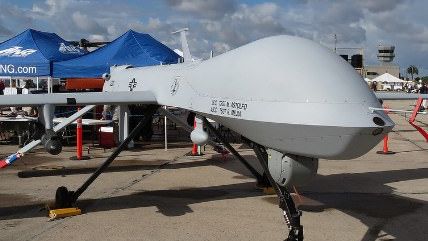A New Whistleblower Exposes America's Drone Assassinations
Unintended targets listed as 'enemies killed in action' without any actual evidence.


We have another Edward Snowden on our hands, and this one has had enough of the way America operates its system of killing people with drones. The source has come forward with a new load of classified information that highlights how risky drone strikes actually are and makes it clear that American officials know full well that they are killing hundreds of people that aren't their actual targets.
Jeremy Scahill and the journalists at The Intercept have been the recipient of all this data from the anonymous person they're referring to as their "source." In a series of stories titled "The Drone Papers," The Intercept describes the massive bureaucracy, technical flaws, and inner workings of America's deadly drone strikes.
The series of stories is huge and I recommend busy folks read at least the first section, "The Assassination Complex," which does an excellent job summarizing all the issues with the program. The other chapters delve further into each component:
The source underscored the unreliability of metadata, most often from phone and computer communications intercepts. These sources of information, identified by so-called selectors such as a phone number or email address, are the primary tools used by the military to find, fix, and finish its targets. "It requires an enormous amount of faith in the technology that you're using," the source said. "There's countless instances where I've come across intelligence that was faulty." This, he said, is a primary factor in the killing of civilians. "It's stunning the number of instances when selectors are misattributed to certain people. And it isn't until several months or years later that you all of a sudden realize that the entire time you thought you were going after this really hot target, you wind up realizing it was his mother's phone the whole time."
Within the special operations community, the source said, the internal view of the people being hunted by the U.S. for possible death by drone strike is: "They have no rights. They have no dignity. They have no humanity to themselves. They're just a 'selector' to an analyst. You eventually get to a point in the target's life cycle that you are following them, you don't even refer to them by their actual name." This practice, he said, contributes to "dehumanizing the people before you've even encountered the moral question of 'is this a legitimate kill or not?'"
By the ISR study's own admission, killing suspected terrorists, even if they are "legitimate" targets, further hampers intelligence gathering. The secret study states bluntly: "Kill operations significantly reduce the intelligence available." A chart shows that special operations actions in the Horn of Africa resulted in captures just 25 percent of the time, indicating a heavy tilt toward lethal strikes. …
The White House and Pentagon boast that the targeting killing program is precise and that civilian deaths are minimal. However, documents detailing a special operations campaign in northeastern Afghanistan, Operation Haymaker, show that between January 2012 and February 2013, U.S. special operations airstrikes killed more than 200 people. Of those, only 35 were the intended targets. During one five-month period of the operation, according to the documents, nearly 90 percent of the people killed in airstrikes were not the intended targets. In Yemen and Somalia, where the U.S. has far more limited intelligence capabilities to confirm the people killed are the intended targets, the equivalent ratios may well be much worse.
"Anyone caught in the vicinity is guilty by association," the source said. When "a drone strike kills more than one person, there is no guarantee that those persons deserved their fate. … So it's a phenomenal gamble."
There will undoubtedly be more to come. Below, a ReasonTV interview with Scahill, author of Dirty Wars: The World Is a Battlefield:


Show Comments (125)